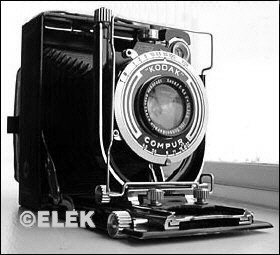well i could mention about the same cameras (although they are great) , but i thought why not throw something else in there that goes largely unnoticed just for the hell of it, it is in a sence one of my favourite
so, how about this...barring a rangefinder its got the lot, but then with this you dont actually need a rangefinder
😛🙄
its the baby 6.5x9 Welta Watson and it fits in the palm of your hand, so its.. compact & ergonomic hehe! no auto pop out for the lens but it slides out smooth and easy, the quality is fine, feels solid and the chrome on the rails must be god knows how thick as i have rarely ever seen one with poor chrome even now some 80+ years on
thieves wont pinch it if you have it sitting beside you on the cafe' table; because when folded it looks more like a book than a camera and not many theives go around stealing books eh. not to mention they wouldnt know how to open it...its always a small sence of amusement when i hand the camera closed to someone and watch them try to to figure out how to open it (i am easily entertained:angel
🙂 . its the hiden button under the leather for those that dont know. hmm maybe i should of kept that secret...kind like telling what someone happend at the end of the movie
😡
three diferent ways to compose your image:- big brilliant finder which
is brilliant not to be compared with the puny little ones you often see and get on later folders; sports
folding frame finder no worries about it yellowing with age like albada finders or a squinty view like the bessa, doesnt even need cleaning and remains crystal clear! or use the
ground glass viewer, it lets you see exactly what the lens is seeing so its just like an SLR hey
😀 and with this method it works better than a rangefinder and needs no adjustment, maintenance or resilvered mirrors
🙂 (actually my young daughter when i showed her this feature and how to use it said 'hey thats just like (does the same as) the viewer on the back of a digital camera' LOL--the things kids say eh! then i thought yeah how true, no batteries and its live veiw as well unlike a Leica M8 haha
😛
focusing methods; take your pick of using hyerfocal and the quick viewfinders for street shooting lol, or use the scale distance focusing with the markings laid out on the bed, or for precise focusing, use the rack and pinion dial to adjust fine increments for precision focusing while viewing the ground glass veiwer; what you see is what you get. as for sturdiness no problems, unless you drop it on it on the front bed they are good, as is the front standard...oh i forgot to metion ther is that advantage of single unit lens focusing as well
(as i am writing this i am starting to think why i need anything else haha)
as for lenses well take your pick, the choices are almost endless with this Welta Watson (3 element, 4, 5 or 6 element lenes) barring the voigtlander range , everthing from the quality triplets that have been used on cameras ever since (including many of those mentioned earlier) to the xenar, tessar, and yes even leitz gave their seal of approval to Welta and were happy to make available their elmar glass on this particular camera as well, dogmars and
many more. ....it occures to me that it is likely possible that it could be retrofitted with some modern lenses without too much diffculty as well, as there appears to be enough room to do so...just a thought
no doubt someone is thinking 'film availability problems'. well true its not as easy to get as 120 but it is available online at a few places and will store forever in the freezer. an advantage is that this film in its holders will be flat, eliminating the occurances that some people have with 6x9 folding cameras. but i usually just use a Rada roll film back (there are other brands out there), its has a nice shape that i think doesnt upset the look of these camera and makes it as convienent as any 6x9, with almost the same format as originanly intended.
and to top it off it has rise, fall and shift that works as easy as turning a knob. most people would not appreciate the benifits of these but once you have it you will enjoy using it.
depending on how you look at it . it doesnt have the versitility of a full on field camera but what a great feature to have in a book size 6x9 folder, that even though it does have square sides still can fit in you pocket. in fact it is smaller in size both in height and width (although thicker by a small margin) than a 6x6 perkeo (often noted for being a(the) pigmy size camera), of course thats not counting the rada film back which on its own isnt too big either, but hey put it in you other pocket if you dont want to leave it atatched to the camera
i just wanted to show something we dont usualy mention but i bet i convinced someone hehe
😀😀



